Excerpts from Jim Conrad's
Naturalist Newsletter
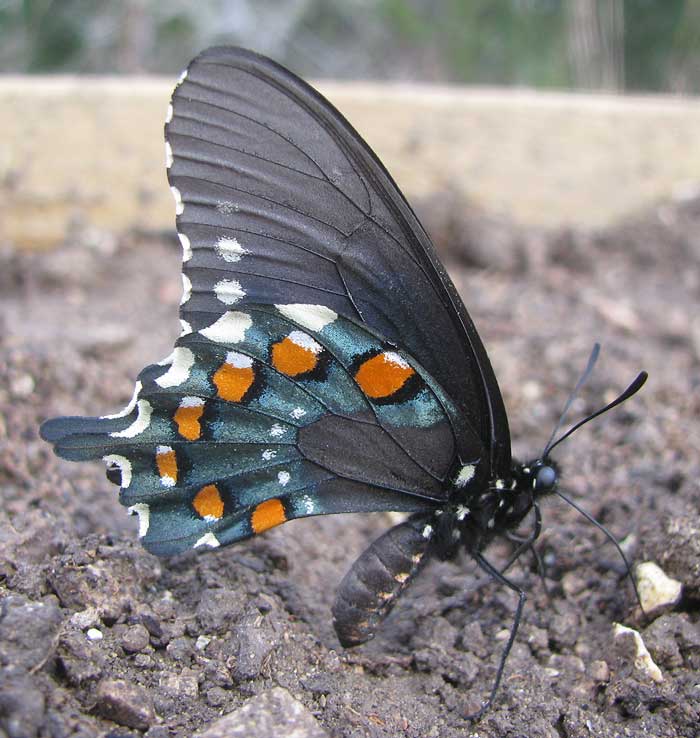
from the February 23, 2014 Newsletter issued from the Frio Canyon Nature Education Center in the valley of the Dry Frio River in northern Uvalde County, southwestern Texas, on the southern border of the Edwards Plateau; elevation ~1750m (~5750 ft); N29.62°, W99.86°; USA
FIRST SWALLOWTAIL OF THE YEAR
This week's unusual warmth encouraged several butterfly species to emerge, the largest being the Pipevine Swallowtail shown above. An abstract close-up of color details of the hindwing can be admired below.
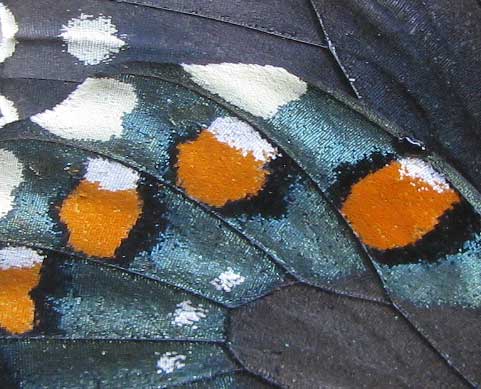
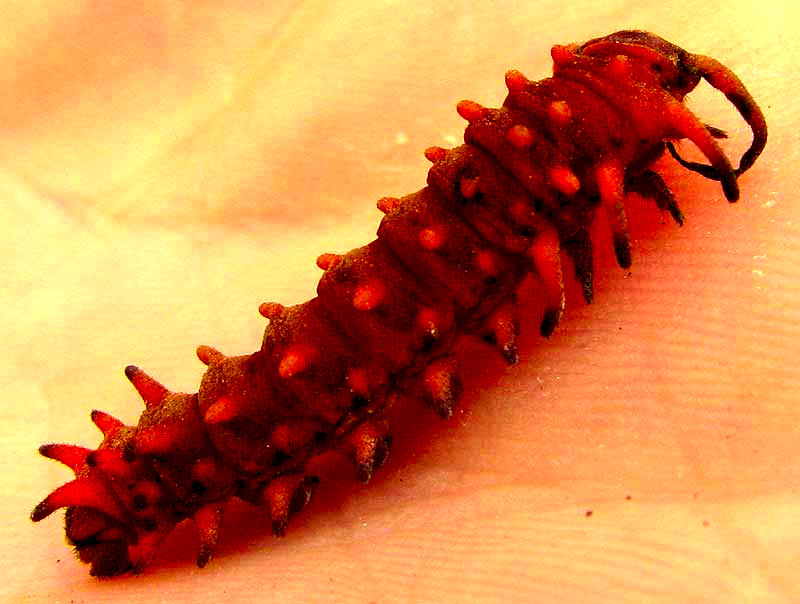
from the June 2, 2013 Newsletter issued from the Frio Canyon Nature Education Center in northern Uvalde County, southwestern Texas, on the southern border of the Edwards Plateau; elevation ~1750m (~5750 ft); N29.62°, W99.86°; USA
PIPEVINE SWALLOWTAIL CATERPILLAR
On a hot, sunny day in mid afternoon, in the center of the gravel road running to the cabin, an orange caterpillar a little over an inch long (3cm) slowly made its way from one side of the road to the other. It was so hot I wondered how he'd traveled so far without succumbing to the heat. That's him above after he was retrieved from his little desert.
He's an unusual looking little fellow with those orange, finger-like spines and with such fleshy, downward-curved antennae on his head (the end at the top, right) being dragged along the ground. I figured there must be a story behind a brightly colored caterpillar allowing himself to be so clearly visible, even attention-getting, in such an inhospitable environment in the middle of the day, so off our picture went to volunteer identifier Bea in Ontario, who promptly replied that she'd been waiting for that very picture.
She'd been waiting because she knew that in our area maybe the most conspicuous butterfly awing at this season is the Pipevine Swallowtail, BATTUS PHILENOR, but until now I'd not sent her a picture of the Pipevine Swallowtail caterpillar. So, here it was. And that explained a bit.
For, Pipevine Swallowtail caterpillars eat the leaves of plants in the Pipevine Family, which contain chemicals that are poisonous to most animals, but not the caterpillars. Young caterpillars contain little of the poison but as they eat and grow the concentration of the poisons in their bodies increases until birds and other predators know better than to eat them. The caterpillars' bright orange coloration warns predators to stay away. Such poison-containing caterpillars that predators know to avoid don't need to restrict their travels to the night or to hidden passageways; they can cross a bright road in mid afternoon.
And, there's a reason why they might want to do it in the mid afternoon instead of waiting until the ground doesn't sizzle their feet. So far I haven't noticed any plant members of the Pipevine Family around here -- though there must be to support the large numbers of Pipevine Swallowtails -- so Pipevine Butterfly caterpillars must have to travel often looking for food.
Our orange caterpillar was a young one, for young Pipevine Butterfly caterpillars are known to be orange, but as they grow and approach the time when they metamorphose into a chrysalis they turn black, but retain orange-red spines, in which case maybe they look even more poisonous than when they were smaller and orange.
from the December 15, 2013 Newsletter issued from the Frio Canyon Nature Education Center in the valley of the Dry Frio River in northern Uvalde County, southwestern Texas, on the southern border of the Edwards Plateau; elevation ~1750m (~5750 ft); N29.62°, W99.86°; USA
PIPEVINE SWALLOWTAIL CHRYSALIS
At the community restroom in the valley, in a dry, well protected corner beneath the eaves on the men's side, a butterfly chrysalis was stuck to the horizontal surface by silk. Chrysalises constitute the pupal stage of butterfly metamorphosis. Remember: egg --> caterpillar --> chrysalis --> adult. Below, you can see the chrysalis:
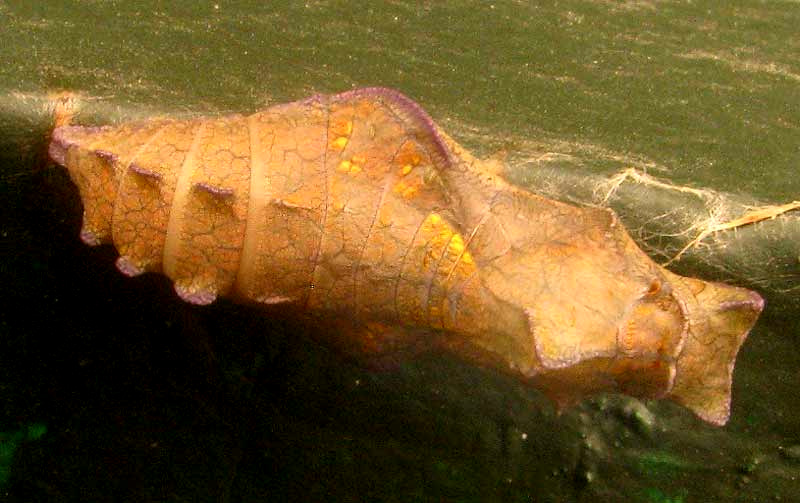
Volunteer identifier Bea in Ontario recognized this as the chrysalis of a Pipevine Swallowtail butterfly, which makes sense because that's one of our most common butterfly species. A view of the same chrysalis from the side is shown below.
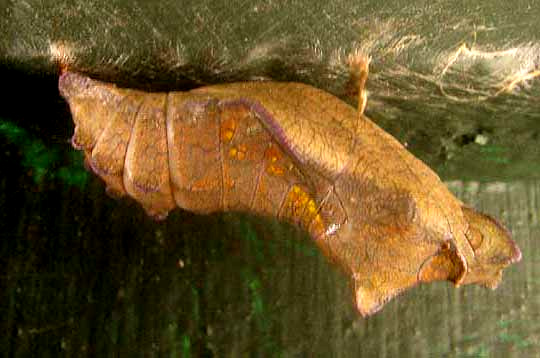
Last January another Pipevine Swallowtail chrysalis husk turned up beneath a Sotol leaf, but it was only a husk, possibly emptied by a parasite that had eaten the pupa from the inside. That chrysalis didn't show the colors and detail seen in our present finding, though. It's shown in the next section.
I'm surprised that we have so many Pipevine Swallowtails here because so far I haven't found a pipevine plant here, and that's the only food of the Pipevine Swallowtail caterpillar.
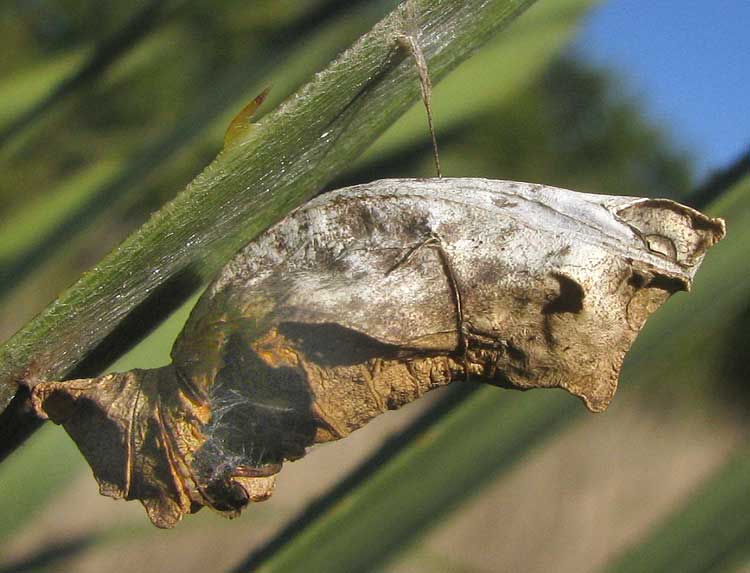
from the January 13, 2013 Newsletter issued from the valley of the Dry Frio River in northern Uvalde County, southwestern Texas, on the southern border of the Edwards Plateau; elevation ~1750m (~5750 ft); N29.62°, W99.86°; USA
CHRYSALIS BENEATH A SOTOL LEAF
Butterflies undergo complete metamorphosis, so their life cycle consists of egg --> caterpillar --> pupa --> adult. The word chrysalis is a special term applied to the butterfly's pupa. Usually a chrysalis with its tough but thin shell is tucked in some obscure spot so that the incredible transformation the larva must undergo during its metamorphoses into a butterfly can take place without botheration from the outside world.
Sotol is an agave-like, card-table size plant with tough, spiny-edged blades mostly found in the desert but also growing here in cobblestone flats along the river.
So, the other day I noticed a chrysalis attached to the lower surface of a Sotol leaf by two silk threads, as shown above. The chrysalis was about 1¼ inches long (3cm) and because of its distinctive shape I figured volunteer identifier Bea in snowy Ontario might enjoy trying to identify it.
Bea was pretty sure it was a Pipevine Swallowtail chrysalis, though chrysalises of other swallowtail species are very similar. Moreover, she thought she saw a story in that picture.
She guessed that the chrysalis had been parasitized by something, maybe a wasp that upon emergence created the hole clearly visible in the side near the bottom. Bea thinks that the butterfly never emerged from the chrysalis, especially because there's no opening at the chrysalis's top where the adult would have emerged. She sent a link to a butterfly-fancier's forum where folks were complaining about losing their Pipevine chrysalises to parasitic wasps.
It took Bea a couple of days of noticing details in the photo and thinking about it all, but, in the end -- as always is the case in nature study -- paying attention paid off with an interesting insight.
from the September 28, 2014 Newsletter issued from the Frio Canyon Nature Education Center in the valley of the Dry Frio River in northern Uvalde County, southwestern Texas, on the southern border of the Edwards Plateau; elevation ~1750m (~5750 ft); N29.62°, W99.86°; USA
GHOST CHRYSALIS
Suspended among branches on a Nandina bush next to the house I was painting, a pure white butterfly chrysalis turned up with narrow black bands. It's shown below:
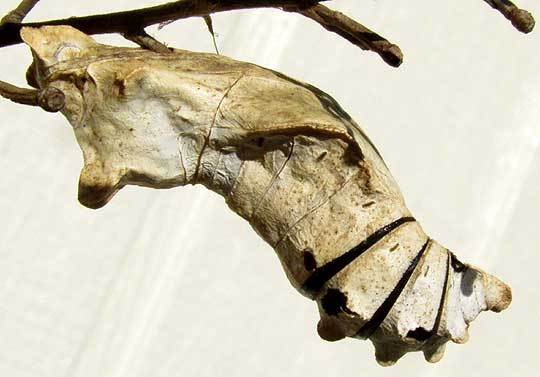
Chrysalises constitute the resting pupal stage between a butterfly's caterpillar and adult forms. Though I've never seen a chrysalis colored like this white one, its shape and the manner by which it suspends itself from a twig with a thin silk connecting its upper middle section with the twig is exactly like that of our most commonly noticed chrysalis, that of the Pipevine Swallowtail.
Assuming that this is indeed a Pipevine Swallowtail chrysalis -- and volunteer identifier Bea in Ontario assures us that it is -- why was this one white? If you look at our picture closely you can see black holes at its bottom. This looks like where an internal parasite might have exited the chrysalis's body after killing the metamorphosing pupa by feeding on it.
The parasitic wasp known as Trogus pennator inserts its eggs into swallowtail caterpillars, the eggs hatch into larvae that then feed on the living caterpillar. However, the larvae don't injure the caterpillars enough to kill them, for the caterpillars still manage to pupate. But the pupae do die, leaving behind pupa shells like ours from which adult Trogus pennator wasps eventually emerge. You can see a Trogus pennator laying its egg on a Black Swallowtail caterpillar at https://bugguide.net/node/view/431190.
So, maybe it's just normal for parasitized Pipevine Swallowtail chrysalises to turn white when they die. That doesn't explain the white chrysalis's elegant black bands, though.